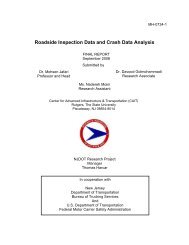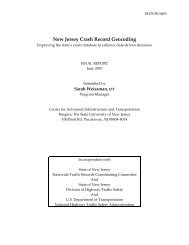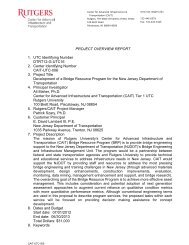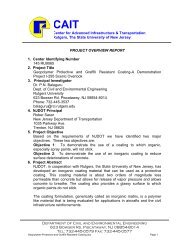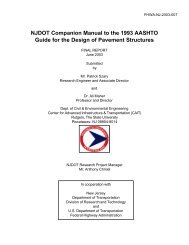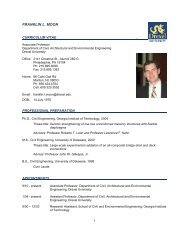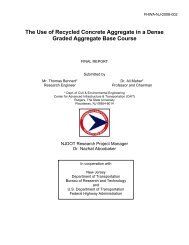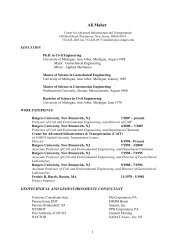Short Line Rail: Its Role in Intermodalism and Distribution
Short Line Rail: Its Role in Intermodalism and Distribution
Short Line Rail: Its Role in Intermodalism and Distribution
You also want an ePaper? Increase the reach of your titles
YUMPU automatically turns print PDFs into web optimized ePapers that Google loves.
One measure of the vitality of the U.S. economy is to look at the amount of goods<br />
transported by freight. In 2002, <strong>in</strong> the U.S., 53 million tons of goods valued at more<br />
than $36 billion (2002 dollars) were transported each day. The freight volumes are<br />
projected by the Freight Analysis Framework (FAF) to <strong>in</strong>crease by 92% by 2035. The<br />
national expenditure on freight transportation <strong>in</strong> the United States is estimated to be 5%<br />
of Gross Domestic Product (GDP). The value of freight moved on the U.S.<br />
transportation system is <strong>in</strong>creas<strong>in</strong>g faster than tons transported, even when calculated<br />
<strong>in</strong> 2002 prices. The FAF 2007 provisional estimate <strong>and</strong> 2035 forecast expect the value<br />
of shipments to <strong>in</strong>crease between 3.1 percent <strong>and</strong> 3.5 percent per year while tonnage is<br />
predicted to grow between 2.0 percent <strong>and</strong> 2.1 percent per year – go<strong>in</strong>g from slightly<br />
over $13.2 billion <strong>in</strong> 2002 to almost $41.9 billion <strong>in</strong> 2035 (2002 dollars) (FHWA, 2008).<br />
Not surpris<strong>in</strong>gly, transportation costs constitute a significant part of the price of f<strong>in</strong>ished<br />
goods. For example, a Canadian study f<strong>in</strong>ds 13% of primary <strong>in</strong>dustry expenditures <strong>and</strong><br />
11% of secondary <strong>in</strong>dustry expenditures are for transportation (Owoc, 1993). One<br />
measure of the performance of the nation's freight transportation system is total logistics<br />
cost. Total logistics cost is the cost of manag<strong>in</strong>g, mov<strong>in</strong>g, <strong>and</strong> stor<strong>in</strong>g goods. The major<br />
components of total logistics cost are adm<strong>in</strong>istration (e.g., management, <strong>in</strong>surance),<br />
transportation (e.g., by truck, rail, air, <strong>and</strong> water), <strong>and</strong> <strong>in</strong>ventory carry<strong>in</strong>g costs. In the<br />
U.S., logistics costs rose through the 1960s <strong>and</strong> 1970s to a high of about 16 percent <strong>in</strong><br />
1980, then decl<strong>in</strong>ed through the 1980s <strong>and</strong> 1990s. Total logistics costs <strong>in</strong> 2003 were<br />
estimated to be about 8 percent of U.S. GDP (FHWA. 2005). These costs are just<br />
those associated with the actual transport of goods. The numbers become larger when<br />
the capital costs of <strong>in</strong>frastructure are <strong>in</strong>cluded, although it is not easy to sort them out<br />
completely s<strong>in</strong>ce railroad capital costs are embedded <strong>in</strong> their rates, while truck<strong>in</strong>g,<br />
barge <strong>and</strong> air freight rates capture some of their capital costs, they do not capture the<br />
full costs of highways, waterway <strong>in</strong>frastructure <strong>and</strong> airport <strong>and</strong> air traffic control systems.<br />
Nevertheless, it is clear that freight transportation is a major component of the U.S.<br />
economy.<br />
The freight transportation <strong>in</strong>dustry is complex. There are multiple firms <strong>and</strong> agents,<br />
often with conflict<strong>in</strong>g objectives <strong>and</strong> motives that <strong>in</strong>teract <strong>in</strong> attempts to maximize or<br />
m<strong>in</strong>imize some particular set of objectives. In addition, transportation <strong>in</strong>frastructure<br />
requires huge capital <strong>in</strong>vestments, <strong>and</strong> frequently has significant implementation delays.<br />
Further, there is stiff competition among the different players <strong>in</strong> the freight <strong>in</strong>dustry.<br />
Often, there is a strong correlation between their decisions, although <strong>in</strong>dependently<br />
taken. F<strong>in</strong>ally, the <strong>in</strong>dustry has to adapt <strong>and</strong> evolve quickly <strong>in</strong> response to social,<br />
economic <strong>and</strong> demographic changes (Cra<strong>in</strong>ic, 1999; Valsaraj, 2008).<br />
It has been said that meet<strong>in</strong>g America’s surface transportation needs for the future will<br />
require a strategy that goes beyond just “more of the same.” It will require a multi-modal<br />
approach, which preserves what has been built to date, improves system performance,<br />
<strong>and</strong> adds substantial capacity to highways, transit, freight rail, <strong>in</strong>tercity passenger rail,<br />
<strong>and</strong> better connections to ports, airports, <strong>and</strong> border cross<strong>in</strong>gs (AASHTO, 2007a).<br />
13



